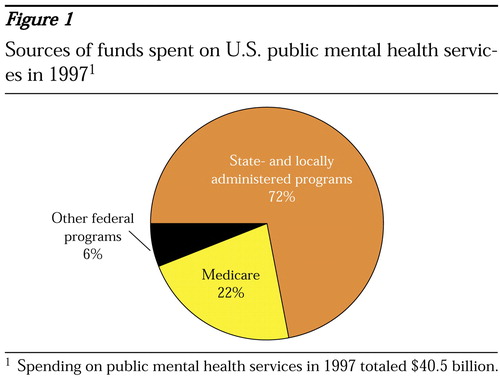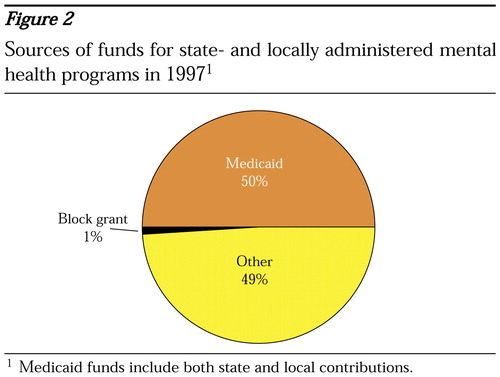Datapoints: Spending for State Mental Health Care
According to recent comprehensive estimates, $73 billion was spent on mental health services in the United States in 1997 (1). From 1987 to 1997, such spending grew at an average annual rate of 4 percent, after adjustment for inflation. Little noted in these figures is a trend that may constitute a major change in the financing and organization of state and local public mental health services, namely, the growing dominance of Medicaid.
Nearly three-quarters of all public funds spent on mental health services are for programs administered at the state and local levels (Figure 1). Some of these services are funded directly by state or local governments, while others are supported by Medicaid, a joint federal-state program. A small percentage of funds comes from the federal mental health services block grant. Recently, another joint federal-state program, the State Children's Health Insurance Program (SCHIP), was added to the state-local component.
Figure 2 shows the proportions of funds from these sources for state and local programs in 1997. Data for both figures are from a study by Coffey and associates (1) and from budget figures for the federal mental health block grant. Because SCHIP did not begin until 1998, it is not shown. Figure 2 underscores the primacy of Medicaid as a payer for state and local mental health services; in 1997 Medicaid paid for half of such services, whereas in 1987 Medicaid paid for slightly more than a third (1).
Medicaid's dominance as a payer for state and local mental health services will probably become more pronounced. In 1999 only Medicaid and the corrections system accounted for a larger share of states' overall budgets than they did at the beginning of the decade (2). The increase is partly the result of active efforts by states to shift programs into Medicaid that were previously funded solely by state or local dollars. This is certainly true for mental health services programs (3).
Few policies or practices recognize Medicaid's growing dominance of state mental health services. Most state mental health agencies administer at least some part of their state's Medicaid mental health funds (4). Nevertheless, no state Medicaid agency produces regular comprehensive reports on its support of mental health, and federal policy does not require such accounting. Efforts to integrate Medicaid data with data from state mental health agencies are still in their infancy. Similarly, state mental health planning councils have no authority to review Medicaid policies that affect mental health services. Addressing these areas and others may help fully integrate Medicaid into the planning and administration of state and local mental health services.
Dr. Buck is associate director for organization and financing at the Center for Mental Health Services, 5600 Fishers Lane, 15-87, Rockville, Maryland 20857 ( [email protected] ). Harold A. Pincus, M.D., and Terri L. Tanielian, M.A., are editors of this column.

Figure 1. Sources of funds spent on US. public mental health services in 19971
1 Spending on public mental health services in 1997 totaled $40.5 billion.

Figure 2. Sources of funds for state- and locally adminitered mental health programs in 19971
1 Medicard funds include both state and local contributions
1. Coffey RM, Mark T, King E, et al: National Estimates of Expenditures for Mental Health and Substance Abuse Treatment, 1997. SAMHSA pub SMA-00-3499. Rockville, Md, Center for Substance Abuse Treatment and Center for Mental Health Services, July 2000Google Scholar
2. National Association of State Budget Officers:1999 State Expenditure Report. Washington, DC, National Association of State Budget Officers, June 2000Google Scholar
3. Coughlin TA, Zuckerman S, Wallin S, et al: A conflict of strategies: Medicaid managed care and Medicaid maximization. Health Services Research 34:281-293, 1999Medline, Google Scholar
4. Lutterman T, Hirad A, Poindexter B: Funding Sources and Expenditures of State Mental Health Agencies: Fiscal Year 1997. Alexandria, Va, National Association of State Mental Health Program Directors Research Institute, July 1999Google Scholar



